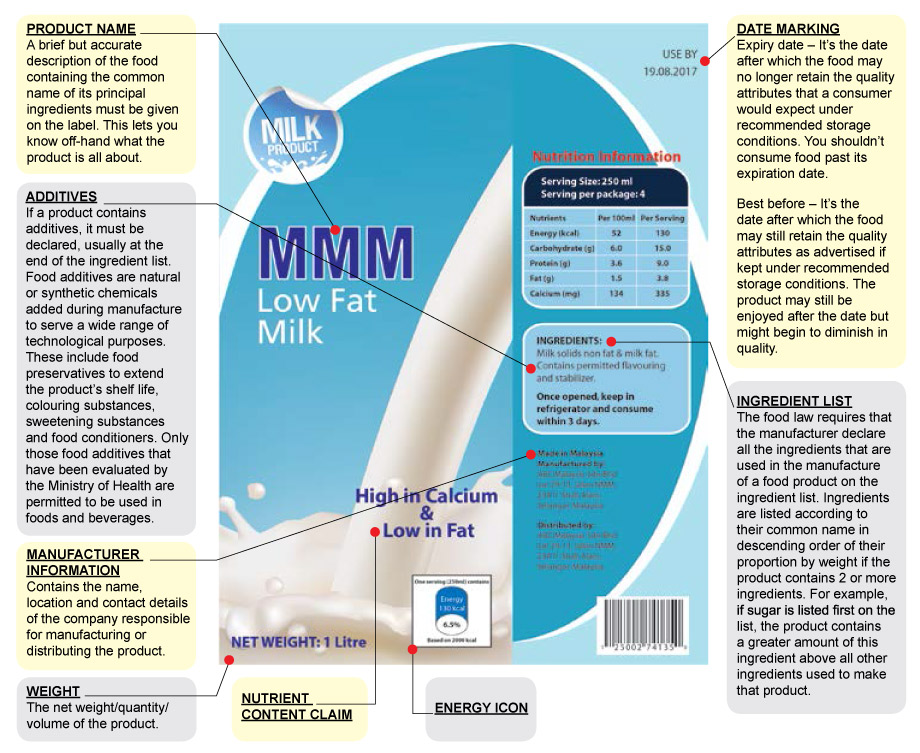Have you ever wondered what all the markings and labels on pre-packaged food products are all about? Or perhaps you are one of those who never even gave it a second glance, except for the brand and the price. But when it comes to buying food products, reading and understanding the labels can help you make better dietary decisions.
By law, manufacturers are required to label their goods with specific information such as product name, ingredient list, food additives, date marking, weight/volume, and manufacturer information. Be sure to browse through this information especially when you are purchasing a new product because it can provide useful information. Doing so will help you decide if the product is best for you and your child.

In addition to the basic information given , it is also mandatory for manufacturers to include a nutrition information panel (NIP) on the label. They can also include other nutrition related information as well.
NUTRITION INFORMATION PANEL
The nutrients that must appear on this panel are energy, protein, carbohydrate and fat. The last three are the main macronutrients needed by our body to provide energy and perform other vital bodily functions.
The nutrition label is also required to state the serving size (in grams for solids and ml for liquids) & the amount of serving per package.
Vitamins and minerals – which are also essential to our diet – may also be declared on the NIP, provided they are present in significant amounts. Other optional nutrients that you may find on the NIP include cholesterol and sodium. If the product is a ready-to-drink beverage, the amount of sugars in it must also be declared.
The primary objective of the NIP is to describe the nutritional qualities of a particular food item. This helps you, the consumer, make better food choices when planning your daily meals. The NIP is a great tool to help consumers compare between different brands of food.
FRONT-OF-THE-PACK ICON FOR ENERGY
This icon provides you quick information on the amount of calories that are in a product as well as its percent contribution to total daily requirement. This helps consumers to choose wisely and plan their daily energy intake according to their needs. It is calculated based on the average daily energy requirements of an adult (2000 kcal).
NUTRITION CLAIMS
You may have noticed some labels have claims such as “high in ……” or “source of …..” certain vitamins or minerals. Or claims such as “free of … ” or “low in …. ” certain nutrients such as sugar, or fat or cholesterol. These are called nutrient content claims and are permitted under the food law.
Other nutrition claims permitted are nutrient function claims such as: “calcium is important for strong bones and teeth”. Or a claim such as: “beta glucan may help to lower blood cholesterol”. In both instances, it is the responsibility of the manufacturer to ensure that the food meets certain requirements or criteria before they can make such claims.
Be wary if a product claims that it can cure, treat or prevent you from a disease. The law does not permit such claims to be made because no food can cure, treat or prevent a disease.
Nutrition claims provide you with further information about a nutrient or a food. They can also guide you in making food choices. However, you shouldn’t rely on the claims alone to make your choices, consider other information as well, especially the nutrients declared on the NIP.
Which One Should You Choose?
You’re in a grocery shop and you need to choose between buying flavoured milk brand A or B. Don’t worry, use the nutrition information in the NIP to help you make your choice of brand.

Tips to help you compare different brands of similar products and make appropriate choices :
- Compare based on nutrients in per 100 ml (or 100 g) of the product.
- Consider the level of several nutrients and not just one.
- Go for products with less energy, sugar, salt (sodium) and fat.
- Always go for products with high protein, vitamins, minerals and dietary fibre.
Finally, next time you go grocery shopping, bring your child along. It’s a great opportunity to teach them how to read food labels and to get them interested and involved in choosing healthier foods.
An educational collaboration with Nutrition Society of Malaysia.





Comments